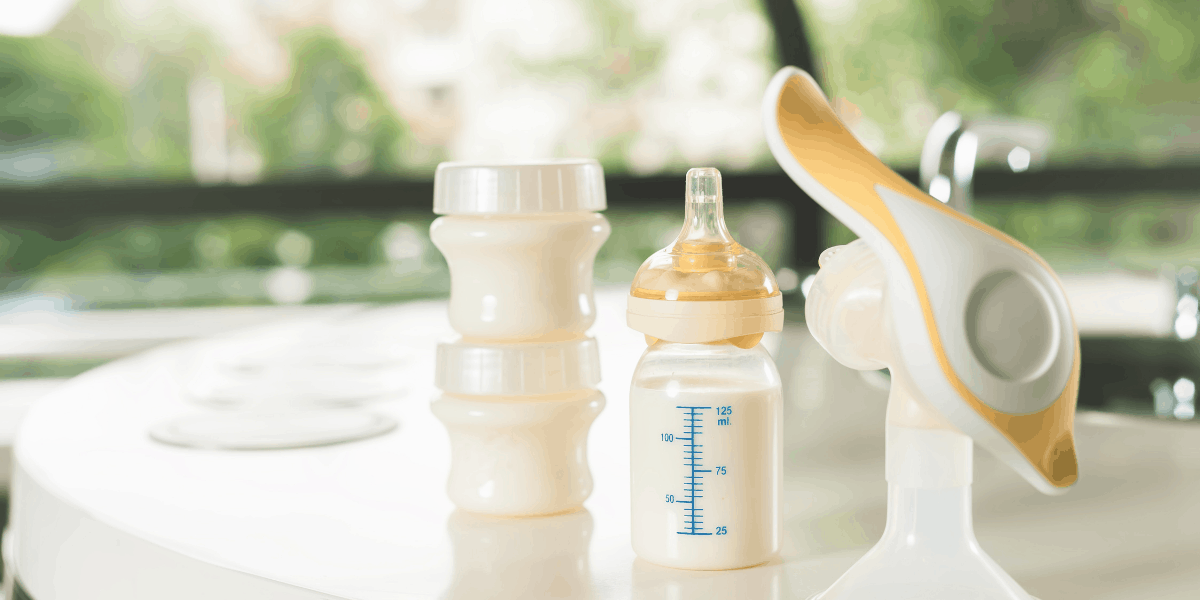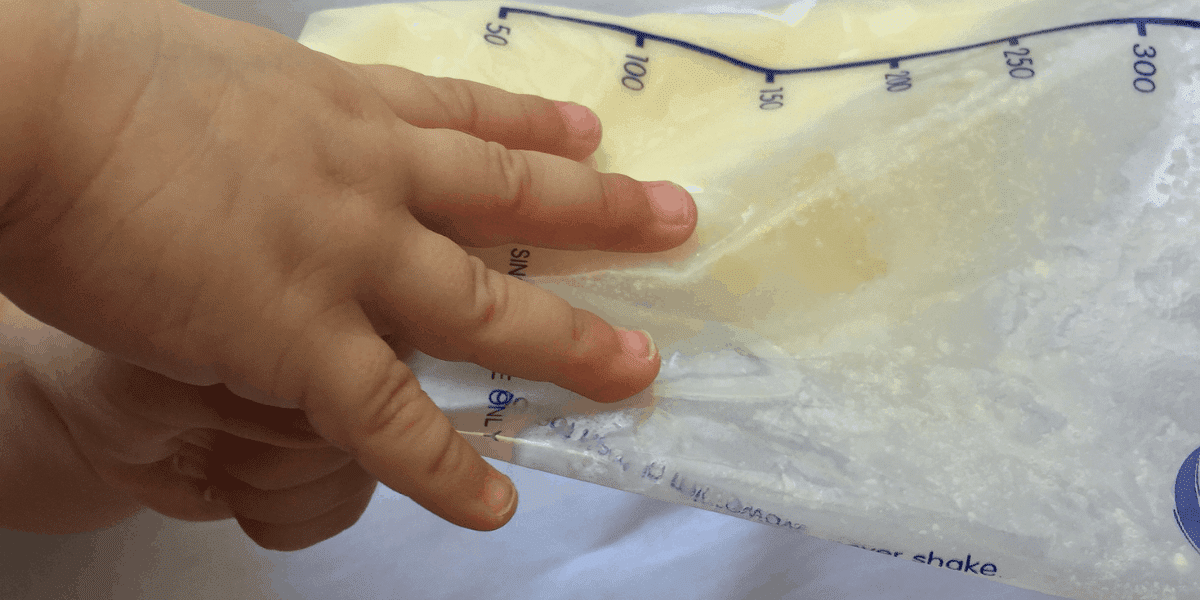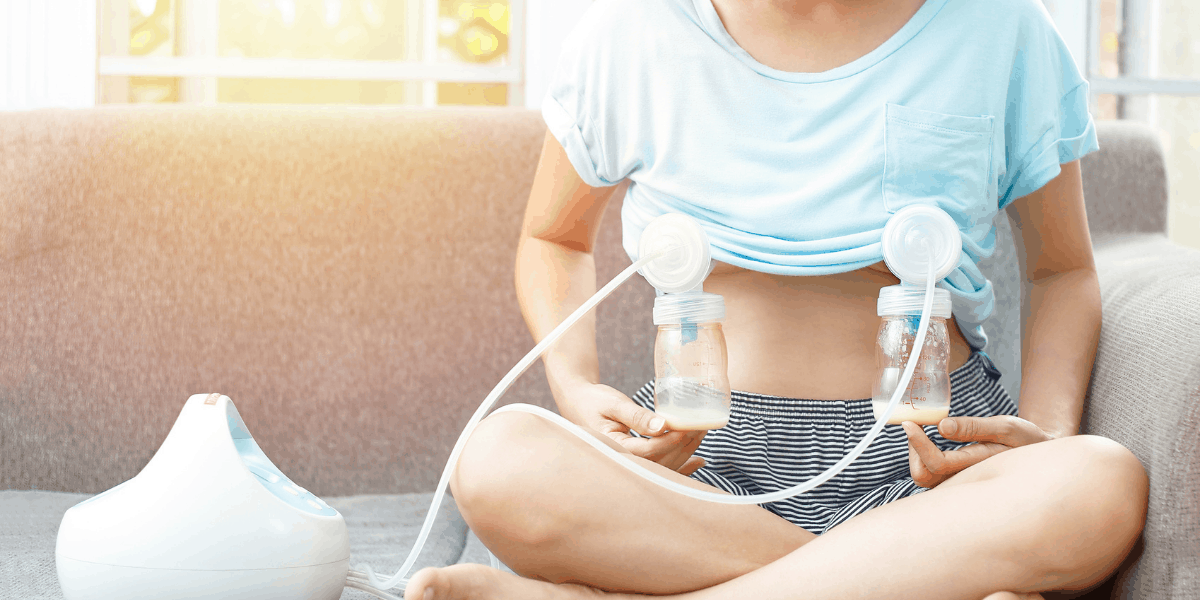Pumping breastmilk is a great way to enable others to feed your baby while you work or take a break. You may also reach for the breast pump if you produce a lot of milk, or your baby does not want to feed when you have full breasts.
While pumping milk is beneficial to your baby, and you, it is not always very easy. Pumping can be painful and uncomfortable, especially when you start, so every drop of milk should be savored.
You can store breast milk in your fridge or freezer and thaw when your baby is ready for a feed. If you notice that thawed breast milk looks grainy you may be wondering if it is safe to drink. We look into the best ways to store breast milk and how grainy breast milk is not necessarily something to worry about
As an Amazon Associate I earn from qualifying purchases. The links below may be affiliate links. Please read my disclosure policy for more information.

Storing pumped milk
When you cannot be with your baby, expressed milk is the best option if your baby is breastfed. For your baby to enjoy expressed milk safely you need to ensure that it is stored safely.
Freshly pumped breastmilk is best for your baby but if you are at work or you are taking time away from your baby this is not always possible. In this instance you will want have a supply of pumped milk in your refrigerator or freezer.
Refrigerated breastmilk will still be very beneficial to your baby, helping you baby get the vitamins and antioxidants that they need.
The first step that you need to take is to hygienically pump your milk from your breast and transfer to storage bags or containers. If you are planning on freezing a large quantity of milk storage bags are handy for laying flat into small spaces.
When storing breastmilk you should follow the guidelines below:
Room temperature (60 °F to 77 °F)—4-6 hours*
Refrigerator (39 °F or less)—3-5 days*
Freezer (0 °F or less)—6-9 months*
*the longest date is under the condition that milk is pumped in a very clean environment. This means that your breast pump and any accessories are sterilized regularly as are the bags and containers used to store the pumped milk. It is best to store your milk in the coldest part of the refrigerator and not the door storage which often reaches a higher temperature.
If you are unsure on how to express your milk safety speak to your family practitioner or post-natal nurse.
Use your Breastmilk to make Lotion: Numerous Benefits for you and your Baby
Using pumped breastmilk from the refrigerator
As breastmilk cools it begins to separate with a fatty (creamy) layer forming at the top and a watery layer underneath. This is normal and you should not worry or discard your precious milk.
Before feeding your baby pumped milk give it a little swirl with a clean implement, trying not to shake as you may cause it to lose some of the beneficial properties.
Your baby may not like chilled milk as they will be used to drinking milk warm from the breast and cold milk will be too harsh on the baby’s stomach. It is best to take the milk out of the refrigerator and bring to room temperature.
Increase your Breastmilk with these Superfoods

Using pumped breastmilk from the freezer
When thawing breastmilk you should take the following steps:
- If defrosting in the fridge please leave 12 hours to ensure it is fully thawed. This is the bets process as opposed to thawing at room temperature.
- Allow thawed milk to be kept in the fridge for no more than 24 hours.
- If you are using the milk straight after it is thawed, leave at room temperature for no more than 2 hours or less if you live in a hot area.
- Never re-freeze thawed breastmilk.
- Do not try to quickly thaw by using boiled water or a microwave as this could lead to an uneven distribution of heat, with some thawed milk and some frozen bits.
However you choose to store pumped breastmilk it is advisable to store in small quantities. This is so that you do not waste any milk as once it has thawed and/or been brought to room temperate it cannot be used again.
You will find that most babies will only take a small amount of expressed milk when they first transition from breast to bottle.
It may bee tempting to put a bottle of thawed milk back in the fridge if your baby does not take it on the first offering but any contact with baby’s mouth and the bottle can cause bacteria which will grow if left until the next feed.
How to start Pumping while Breastfeeding
Warming breastmilk
To bring your pumped breastmilk to the correct temperature for feeding your baby you should take the storage container or bag out of the fridge and pop into a bowl of lukewarm water and leave until it reaches 99 °F.
There are products on the market, such as bottle warmers, that can help warm refrigerated milk but do make sure they pass safety guidelines. As the milk comes to the correct temperature gently swirl around to combine the separated layers.
By following the above steps to pump, store and thaw your breastmilk you will limit the chances of it spoiling. You may notice that your milk smells different once it is thawed but this is normal.
To prevent harmful bacteria developing the enzymes (Lipase) in the breastmilk break down the fats which can make take on a fruit smell. This process also helps the baby digest the milk so it is beneficial to your baby.
How long can you leave Breastmilk out after warming it up?
Why is my breastmilk grainy?
If you follow correct safety guidelines it is unlikely that you will need to discard of the liquid gold that is pumped breastmilk. If you notice thawed milk is grainy do not rush to flush it down the sink.
As mentioned, your breastmilk will split as it cools, with a thicker layer forming at the top of the storage container and a watery layer forming at the bottom of the container.
As the two layers mix small grains start to appear and, sometimes, larger chunks that may look like the milk has curdled. Some people describe the thawed milk as having white spots, similar to when you mix cream and milk when baking—again, this is normal.
10 Reasons Exclusively Pumping Is Easier than Breastfeeding

How do I know if my thawed breastmilk is bad?
Now you know that grainy milk is normal after it is thawed you may be wondering hot you can tell if it is off. Spoiled breastmilk will have a distinctive sour smell, similar to that of cows milk that has turned.
Remember that the small will change slightly during the cooling and thawing process so if you know that you have followed the correct steps in pumping, storing and thawing your milk then the chances are that it is fine for your baby to consume. Some women produce more lipase than others so the smell of breastmilk varies from one woman to the next.
To be fully confident that your breastmilk is good to drink you can take a small taste yourself, although it may not be the best flavor for you. Generally, you can take cues from your baby and if they are refusing to drink the milk when they usually do not have an issue then he milk may be off so you should go ahead and pour away.
If you do notice that you produce a lot of lipase and the smell of your breastmilk is off-putting for you and your baby you can try scalding the milk before you store.
This is done by boiling up the milk in a sterile pan as soon as you have pumped and cooling it in the fridge as soon as it is heated and you can start to see air bubbles.
The milk is then stored as normal but the heat could reverse the lipase breakdown process. This is not recommended if you solely pump and feed with a bottle as it can lower the level of nutrients the baby receives.
What is Power Pumping and does it Work?
Can I give my baby the grainy milk?
While grainy breastmilk is normal, a simple heating and stirring process will help the layers blend and make the milk look more appetizing. This is especially important if there are larger grains or lumps as it will make it difficult for your baby to drink as it will clog up the teat.
Gently swirling with a sterilized spoon should bring it to the consistency that you need or you may want to give it a gentle shake for stubborn lumps.
If you are ever in doubt about any stage of the pumping process and you are not 100% sure the milk is safe for your baby to drink it is best to discard, as disheartening as that may be.
The good news is that the more you practice pumping and storing milk the easier the process will come and you will soon be happy with your routine.





